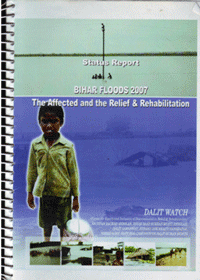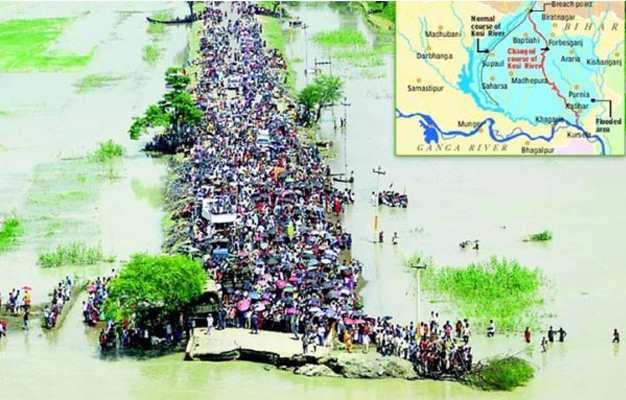|
|
|
|
|
Formation of Dalit Watch
|
|
Assessment conducted by various organizations in Bihar in the aftermath of the floods of 2007 confirmed the fact that relief distributed by the government was far short of the actual need and many villages were yet to receive them. Further, even where relief was distributed, dalits and other marginalized communities had very limited access and discrimination was extensive. This was raised in the coordination meeting between the state and INGO/NGOs. There was consensus among a few organizations to work together on eliminating discrimination and ensuring equity and inclusion in relief measures. ‘Dalit Watch’ emerged as the platform of these organizations. Members include Bachpan Bachao Andolan, Lok Shakti Sangathan, Baarh Sukhad Mukti Andolan, Dalit Samanway, Nari Gunjan and NCDHR and the collective is supported by Praxis – Institute for Participatory Practices.
Vision of Dalit Watch: A society where all communities irrespective of caste, gender, religion, age, physical ability, class are able to mitigate disaster with equity and dignity.
Salient Strategies
- Assessing damaged of life, habitation and livelihood of marginalized communities through rapid assessment, accessing government database, building database;
- Building a network of cadre at panchayat, block and districts level and orientating them on rapid assessment monitoring mechanisms
- Monitoring state and civil society relief and rehabilitation programme by establishing block, district level Dalit watch center, bring out manual for monitoring of relief and rehabilitation packages, facilitating complaints and demands for equitable humanitarian aid.
- District level advocacy for strengthening demands from the community
|
SSVK and its people,s organization Lok Shakti Sangathan (LSS) along with 5 networks of people,s organization and NGOs conducted an extensive survey in 11 districts among the total 19 affected by flood in Bihar and brought out a Dalit Watch Report 2007.
Bihar is India’s most flood-prone State, with 76% of the population in the north Bihar living under the recurring threat of flood devastation. 16.5% of the total flood affected area in India is located in Bihar while 22.1% of the flood affected population in India lives in Bihar. About 68,800 square kilometers out of a total geographical area of 94,160 square kilometers comprising 73.06% is flood affected. Floods in Bihar are an annually recurring disaster affecting huge human and livestock population and causing huge damages to agricultural crops, houses and public infrastructure. In between 1979 and 2006, floods of varying intensity have ravaged Bihar on an annually recurrent basis affecting on an average an area of 1.39 mha, a human population of 7.71million and a livestock population of 1.55 million per annum. Crop losses have been on an average to the tune of Rs 1423.33 million per annum and that of public property to the tune of Rs 568.30 million. Loss of human lives has been on an average of 210 per annum and that of livestock at 680 per annum.In 2007 flood affected 19 districts in the eastern part of the state.
Status Report Bihar Floods 2007
Previous experience in disasters like Tsunami made it clear that the relief and rehabilitation process in the wake of any disaster is beset with the evils of caste based discriminations.
Dalits population of Bihar is 13048608 which is 15.72 percent of Bihar's population of 83 million. Literacy rate of the Dalits is 28.47 percent. The poorest Dalits were declared Maha Dalits in Bihar. A government commission has identified 21 of the 22 Dalit sub castes, including Musahar, Bhuiyan, Pasi, Dhobi and Chamar Dom, and Nat as Maha Dalits.The commission has not included one Dalit castes - Paswan - in the Maha Dalit category.. A few months ago Nitish Kumar announced a special package of Rs.3 billion ($76 million) for the socio-economic development of the poorest among Dalits. He set up a commission in August last year for the welfare of certain Dalit castes that are socially and educationally more backward than others. Bihar is the first state to constitute a commission to study the status of the neglected Subcastes among Dalits and suggest ways to uplift them. The commission in its first interim report to the government a few months ago painted a bleak picture of the Dalit sub-castes. The report said there were no high school teachers or senior officials from these castes in the state despite reservations in government jobs for them.
21 Mahadalits Castes -Bantar, Bauri, Bhogta, Bhuiyan, Chaupal, Dabgar, Dom, Ghasi, Halalkhor, Hadi, Kanjar, Kuraria, Lalbegi, Mushar, Nat, Pan, Rajwar and Turi., Pasi, Dhobi, Chamar
1 Dalit Caste - Paswan
Since 2007 SSVK has been a part of Dalit Watch in Disaster Mitigation Bihar along with 5 networks of people,s organization and NGOs. In the aftermath of 2007 floods in Bihar, Dalit Watch, a forum for Equity and Inclusion of Discriminated in Relief and Rehabilitation, carried out an extensive survey spread over 11 districts, 112 blocks, 716 panchayats and 2378 villages. On the basis of data of gathered and analysed, the assessment confirmed the fact that relief distributed by the government was far short of the actual need and many villages were yet to receive them. Further, even where relief was distributed, dalits and other marginalized communities had very limited access and discrimination was extensive. This was raised in the coordination meeting between the state and INGO/NGOs. There was consensus among a few organizations to work together on eliminating discrimination and ensuring equity and inclusion in relief measures. ‘Dalit Watch’ emerged as the platform of these organizations. Members include Bachpan Bachao Andolan, Bihar Baarh Sukhad Mukti Andolan, Dalit Samanway, Lokshakti Sangathan, Nari Gunjan and NCDHR and the collective is backed by the support of Praxis – Institute for Participatory Practices. Subsequently the activities of Dalit Watch have been geared towards the following:
 |
Assessing damaged of life, habitation and livelihood of marginalized communities through rapid assessment, accessing government database, building database; Building a network of cadre at panchayat, block and districts level and orientating them on rapid assessment monitoring mechanisms Monitoring state and civil society relief and rehabilitation programme by establishing block, district level Dalit watch center, bring out manual for monitoring of relief and rehabilitation packages, facilitating complaints and demands for equitable humanitarian aid. District and state level advocacy for strengthening demands from the community.
|
 |
Dalit Watch Report on Bihar (Kosi Catastrophe-2008) Flood Relief Camps
In September 2008, Dalit Watch published a report on its findings while monitoring 205 relief camps in the wake of the devastating floods on the India-Nepal border. This report records the damage caused by the breach on the embankment of the Kosi river in August 2008 and appraises the quality of relief efforts in the aftermath of the floods. Research was conducted in the districts of Supaul, Saharsa, Madhepura, Araria, and Purnia.
Outcomes of the monitoring conducted by Dalit Watch indicate a large shortfall in the organisation of critical relief aid across most of the 205 monitored sites, particularly in Madhepura district. Dalit Watch makes several recommendations for the improvement of overall quality of relief and to ensure greater accessibility for Dalit communities in particular.
|

Photo of Kosi Catastrophe 2008

DW and SSVK disaster mitigation meeting with International Agency ( OXFEM, World Bank,Cord Aid, Save theChildren Fund,Christan Aid, UNICEF, Actionaid and Caritas)
|
SSVK
State Co-ordination cum Correspondence Office: |
SSVK
North Bihar Training Cum Field Office |
Emails & Web |
Lok Shakti Bhawan,
Opp:Ajay Nilayan Apartment,
Parmanand Path, Nageshwar Colony
Boring Road, Patna – 800001
Tel/FAX: +91-612-2522077
Mobile: +91-94310 25801
+91-99731 61483 |
J.P. Gram, Balbhadrapur,
Jhanjharpur (R.S.)
District - Madhubani
BIHAR, PIN – 847403 INDIA
Tel/FAX: + 91-6273-222242
Mobile: + 91-99399 84568 |
E-mail (S):
- ssvkindia @ gmail.com
- ngossvky86 @ yahoo.com
- deepakbharti @ ssvk.org
Web : http://www.ssvk.org |
|
Registered under Society 1860, Income Tax-Tan, Pan, 12A and Exempted under 80 G
|
|